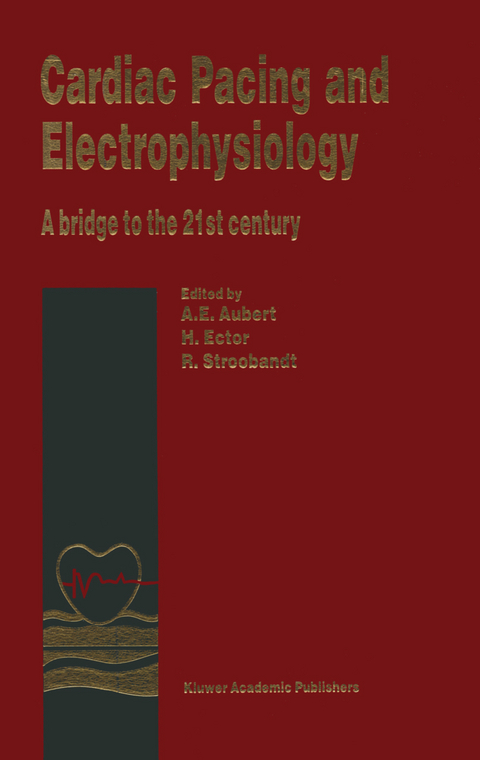
Cardiac Pacing and Electrophysiology
Springer (Verlag)
978-94-010-4377-9 (ISBN)
One: Electrophysiology.- 1. Equipment for the electrophysiology laboratory: possibilities and limitations.- 2. Vasovagal syncope: clinical presentation, classification and management.- 3. Classification of antiarrhythmic drugs in relation to mechanisms of arrhythmias.- 4. Electrophysiological characteristics in arrhythmogenic right ventricular dysplasia and dilated cardiomyopathies.- 5. Classification of death in patients under antiarrhythmic treatment.- 6. Heart rate variability. Methodology and physiological basis.- 7. Heart rate variability and QT interval: their relationships with the cardiac frequency.- 8. Role of dynamic QT interval in Holter tapes to stratify risk inpostmyocardial infarction patients.- 9. Heart rate variability in patients with angina pectoris.- 10. Time and frequency domain analysis of heart rate variability after myocardial infarction.- 11. Signal averaged ECG. Technical principles, possibilities and limitations.- 12. Optimizing the predictive value of the signal-averaged ECG for serious arrhythmic events in the post-infarction period.- 13. Signal-averaged analysis of the P wave: possible applications in different settings.- 14. Late potentials during acute myocardial ischaemia.- 15. Radiofrequency catheter ablation in the treatment of supraventricular tachycardias.- 16. Anatomical versus electrophysiological approaches for ablation of the slow pathway in patients with AV nodal reentrant tachycardia.- Two: Pacing.- 17. Cardiac pacing in Europe in 1992: a new survey.- 18. The myocardium-electrode interface at the cellular level.- 19. The myocardium-electrode interface at the macro level.- 20. Unipolar versus bipolar leads.- 21. Single lead VDD pacing: an update.- 22. Substantial improvement of screw-in electrodes.- 23. Physiological cardiac pacing: an individual objective.- 24. Pacemaker syndrome during atrial-based pacing.- 25. Dual chamber pacemaker therapy in cardiomyopathy.- 26. DDD rate-responsive pacing: state of the art.- 27. Heart rate response based on changes in central venous oxygen saturation, minute ventilation and body activity.- 28. DDDR and atrial arrhythmia.- 29. Holter and pacemaker diagnostics.- 30. Clinical relevance of histograms in the follow-up of DDDR pacemakers.- 31. Holter and telemetry in pacemakers and ICDs: new developments.- 32. Automatic measure of the interface capacitor and the total cardiac impedance.- 33. Critical analysis of the different algorithms designed to protect the paced patient against atrial tachyarrhythmias in dual chamber pacing.- 34. Mode switching in DDDR pacing.- Three: Defibrillators.- 35. Indication for ICD implantation and selection of patients: present and future.- 36. The optimum tilt for defibrillation.- 37. Cerebrovasomotor reactivity predicts tolerance to tiered therapy with implantable cardioverter-defibrillators.- 38. Clinical utility of telemetered electrograms in pacemakers and ICDs.- 39. High patient acceptance for implantable cardioverter/ defibrillator (ICD): quality of life and patient acceptance.- 40. Cardiac pacing and electrophysiology: how much technology do we need?.- 41. Medical technology assessment and reimbursement policy of implantable devices in Belgium: possibilities and limitations for the future.- 42. Socioeconomic aspects of implantable devices: can we afford new technology?.
| Zusatzinfo | XXI, 441 p. |
|---|---|
| Verlagsort | Dordrecht |
| Sprache | englisch |
| Maße | 160 x 240 mm |
| Themenwelt | Medizinische Fachgebiete ► Innere Medizin ► Kardiologie / Angiologie |
| ISBN-10 | 94-010-4377-9 / 9401043779 |
| ISBN-13 | 978-94-010-4377-9 / 9789401043779 |
| Zustand | Neuware |
| Informationen gemäß Produktsicherheitsverordnung (GPSR) | |
| Haben Sie eine Frage zum Produkt? |
aus dem Bereich


